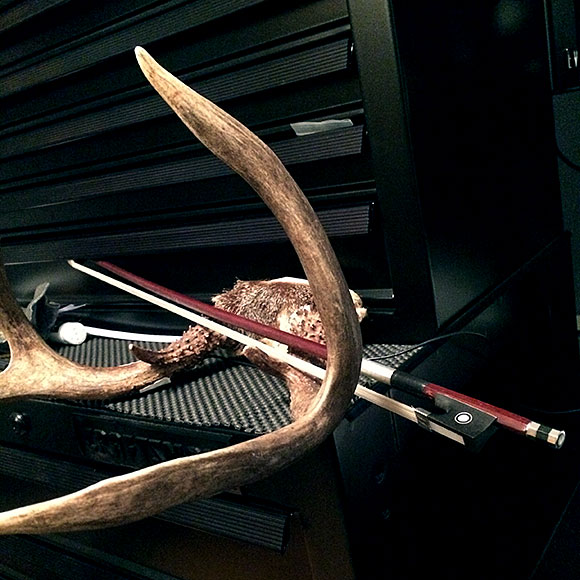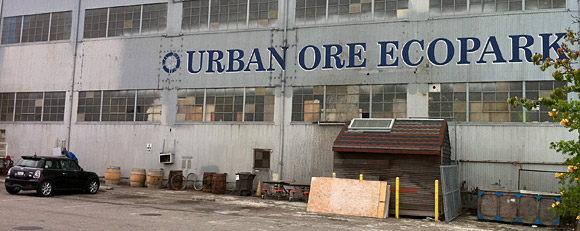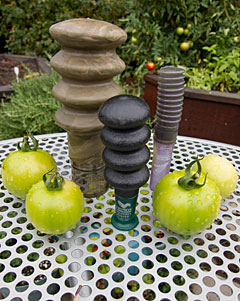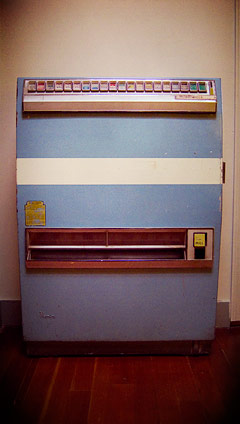Posted: December 20th, 2014 | Author: Nathan | Filed under: found sound objects, music, sound design

A lush nest of sonic discomfort.
Following on my last post, I’ve continued to play around with my recordings of deer antlers through a contact microphone. Today’s sound is almost entirely from that session, with only a handful of synthesized sounds, all triggered by LFOs and other random modulations. The manipulations of the deer antler sounds were done in the very weird, pretty unstable, and utterly unique Gleetchlab application, as well as iZotope Iris, which did an amazing job of figuring out the root frequency of the flute-like and cello-like bowed resonances.
[soundcloud url=”https://api.soundcloud.com/tracks/182406370″ params=”color=ff5500&auto_play=false&hide_related=false&show_comments=true&show_user=true&show_reposts=false” width=”100%” height=”166″ iframe=”true” /]
Tags: found object, music, music 2014, sound design | No Comments »
Posted: December 15th, 2014 | Author: Nathan | Filed under: found sound objects, music, sound design

Most years I host a “white elephant” party: Bring gifts you were given that are pretty bad, re-wrap them, and then you pick from the pile and laugh at the bizarre stuff you unwrap. Last year, I wound up with a pair of deer antlers.
I don’t hunt, yet I have a thing for taxidermy. I have no idea why.
As they sat in my studio, I thought back to an interview I did with Cheryl Leonard for the Sonic Terrain blog a few years ago. I remember her making instruments from limpet shells and other organic objects. Why was I not exploring the sonic possibilities of this strange object on my shelf?
Deer antlers are bone, not hair, so they are riddled with hollow channels, and are extremely tough. The main thing I tried was to explore their resonance, with a cello bow. I had to lay a good amount of rosin on the bow, but they did resonate. The sound is hissy, atonal, but with some pronounced fundamentals and overtones…just not in relationships that one usually considers musical. I used a Barcus Berry 4000 contact microphone and recorded onto a Sound Devices 702 field recorder.
When I hear an interesting sustained sound with too many frequencies, or odd frequency relationships, I usually go to one place to create something musical out of it: iZotope Iris. It’s a very creative tool for making playable virtual instruments out of pretty much any sound. In this case I also used New Sonic Arts’ Granite granular synthesis plugin for several layers. It all sounded very breath-y, like a somewhat melodic whisper. I mixed it with some LFO-driven rhythms in Reason and a bassline and drone from Madrona Labs’ Aalto. It was all put together in Logic Pro X with very few effects, lightly compressed by Cytomic’s The Glue.
Deer antlers, even processed through modern software, aren’t the most flexible or sonically soothing instruments around, but this article can at least serve as a reminder to explore everything around us for its interesting sonic possibilities. You never know what you’ll find.
[soundcloud url=”https://api.soundcloud.com/tracks/181708958″ params=”color=ff5500&auto_play=false&hide_related=false&show_comments=true&show_user=true&show_reposts=false” width=”100%” height=”166″ iframe=”true” /]
Tags: ambient, drone, found object, music, music 2014, resonance | No Comments »
Posted: October 13th, 2011 | Author: Nathan | Filed under: found sound objects, sound design

My mecca on a foggy morning: Urban Ore!
I went to the granddaddy of thrift stores recently, so much so that it’s more of a glorified junk store…but oh, what glorious junk. I’m talking about Urban Ore in Berkeley, California. Sometimes I’m self-conscious shopping for things by ear, picking up random things and just listening to them, but at Urban Ore – heck, Berkeley in general – I can ear-shop in peace.
I was in a metallic mood, so I filled a bag with things that squeak, resonate, creak, clank, and sproing. Based on the dronetastic results of striking wire shelving last year, I picked up a few thin-wire metal grills that had sonic promise, among other things that will surely find their way to this blog later this fall and winter.
For the grills, I decided to trot out my much-neglected piezo contact microphones. The resonant notes were so subtle that it seemed like the best way to capture the sound at a reasonable volume. I plucked them, struck them, and played them with a cello bow. The magic happened, though, when I realized one was easily played with a bow and the other was not, so I stuck the bowable one inside of the other, and played away, causing both of them to resonate when played appropriately.
The results were like ultra-low-fi bastardizations of stringed instruments played in horror movies, and I just loved the character. The rawness of hearing the actual hairs of the bow on the metal, in my opinion, lends to the eerie charm.
[soundcloud url=”http://api.soundcloud.com/tracks/25407627″ params=”show_comments=true&auto_play=false&color=ee0000″ width=”100%” height=”81″ ]
[Contact microphone into Sound Devices 702 recorder]
Tags: creepy, digital audio, eerie, found object, groaning, horror, metal, resonance, sound design, sound effects | No Comments »
Posted: May 12th, 2011 | Author: Nathan | Filed under: field recording, found sound objects, sound design

Eton Mine, Lucky Boy Trail, Joshua Tree National Park, California, USA.
[One in a series of posts from my spring 2011 trip to the southern California desert.]
Joshua Tree National Park is beautiful, but much of its history (prior to being designated a National Park) has scarred and pockmarked its landscape. In the Gold Rush, the Joshua Tree hinterlands held some of the most productive mines in California until well into the 1900’s. These mines were big, sprawling, and deep. To my knowledge, no Balrogs were released as a result. But that would explain a lot about Golden State politics.
We hiked on some lesser-traveled trails and found an acre of land with no fewer than five vertical holes in the ground: Mine shafts. They were all wired off and had metal grates over them. One in particular, the Eton Mine on the Lucky Boy trail, had warning signs on the wire fence surrounding it.
It was quite windy that day, and I just knew I had to get the creaking, squeaking sounds of this battered sign on the rusty wire. It took me a surprisingly long time to figure out how to protect my handheld recorder from the wind, but ultimately I decided to use my body as a shield and then stick it under my microfleece hoody. (I had the OEM fuzzy windscreen on it, which is one of the most useless strips of fabric I’ve ever seen, er, heard.) I just hoped that my body protected it from the 25+ mph wind gusts and that the fabric wouldn’t dampen the high frequencies too badly…and because of the sound, I had high-frequency content to burn.
With some judicious noise reduction in post – subtle, as always, gives the best result – it didn’t come out too shabby, considering the horrible recording conditions and super-no-budget wind blocking techniques!
[soundcloud url=”http://api.soundcloud.com/tracks/15163504″ params=”show_comments=true&auto_play=false&color=ee0000″ width=”100%” height=”81″ ]
[Sony PCM-D50 recorder, capsules at 120°]
Tags: creepy, desert, digital audio, eerie, field recording, found object, industrial, joshua tree, metal, resonance, sound design, sound effects, travel | 1 Comment »
Posted: November 16th, 2010 | Author: Nathan | Filed under: field recording, found sound objects

Home of the ceiling fan in question, and the weirdness that followed.
When in Mexico two years ago, the villa in which I stayed had a ceiling fan with very different voices when set to low and high. I’ve included a short sample of this fan at low, sounding like a grinding motor, and high, when the motor when silent but the blades sounded like a small helicopter.
Weirder than this sound was the villa, which was huge and beautiful, and overlooked the beach and the Pacific Ocean. It was surrounded by a river choked with human filth. Then the Dallas Cowboy Cheerleaders showed up. Then I thought I would die from food poisoning. All in one day.
True story. Tell you more over a beer sometime. Sorry, no cheerleader sounds were recorded.
[soundcloud url=”http://api.soundcloud.com/tracks/7100811″ params=”show_comments=true&auto_play=false&color=ee0000″ width=”100%” height=”81″ ]
[Zoom H2 recorder]
Tags: digital audio, field recording, found object, Mexico, sound design, sound effects, travel | 4 Comments »
Posted: October 28th, 2010 | Author: Nathan | Filed under: field recording, found sound objects

Beer, toiletries, ice chest, field recorders. Yep, that's a well-stocked camping trip!
The metal bearproof food locker is a common sight in the developed campgrounds of the Sierra Nevada mountains. They’re infamously noisy to open, close, and move things around in, and are usually the first sounds you hear in the morning. They do their job, though…provided you have them closed. I once had a close encounter with a bear whose head was stuck right into my slightly open bear locker (in my defense, it was in the midst of dinner preparation), but that’s another story for another blog.
I finally decided to record one on a trip this summer. It was a kayaking trip, so I had both my Zoom H2 [yeah, this is an older sound] and a hydrophone, so I decided to use both: The Zoom would get the stereo effects and the hydrophone would pick up the raw vibrations. I placed the H2 horizontally centered in the locker, and placed the hydrophone on the single shelf inside. Holy resonance, Batman!
Today’s sound is a collection of hits from this outdoors session, made with hands, metal objects, and a rubber mallet, first at normal pitch and then an octave lower. It wound up mixing rather well with my collection of shovel-in-wheelbarrow sounds from a while back. Get those subwoofers ready for the second half…
[soundcloud url=”http://api.soundcloud.com/tracks/6510828″ params=”show_comments=true&auto_play=false&color=ee0000″ width=”100%” height=”81″ ]
[Zoom H2 (120° capsule spread), Aquarian Audio H2a-XLR hydrophone into Sound Devices 702 recorder]
Tags: digital audio, field recording, found object, industrial, metal, microphone, percussion, sound design, sound effects | 8 Comments »
Posted: October 25th, 2010 | Author: Nathan | Filed under: found sound objects, sound design

Trust me, those are animal calls, and this is a PG-13-rated show.
Not all of us have the long schedules or big budgets that support going out to exotic locations – or even the local zoo – to record unusual animals for sound design. There are an increasing number of excellent creature-specific effects collections out there, too.
But another fun alternative is to use animal calls. Mostly created to lure or flush birds for the benefits of hunters, some also mimic the sounds of squirrels and other small animals…they’re not exceedingly realistic, but they do sound pretty neat. These calls can be used as the instructions suggest for some level of realism, but using them in unusual ways can create great base sounds for more extreme uses. On their own, they’re OK, but they’re high-pitched enough that they hold up well to heavy processing. They come in many shapes and sizes, but those that feature bulbs that pass air over a reed can be played more expressively.
These calls have the added benefit of garnering very curious, or suspicious, looks from visitors if you display them in your studio.
Today’s sound is a cute little number called the Squirrel Buster. I Â rattled it back and forth, cupping my hand over the horn to filter the sound just a little. The first portion is the call being shaken back and forth. It doesn’t really sound like any squirrel I’ve heard…in fact, it doesn’t sound unlike the tail end of a hornbill’s call (which many mistake for monkeys, thanks to Hollywood’s use of the hornbill call in jungle films). Perhaps it would be a nice background layer in an exotic ambience. The second portion is the first that’s been sped up to 200%, then pitched down 1.5 octaves; this sounds a bit more gutteral and almost simian. The third portion is the second, run through the GRM PitchAccum plug-in and sped up again by 200%, and it starts to sound like a layer of rapid-fire alien utterances, a la District 9.
[soundcloud url=”http://soundcloud.com/noisejockey/squirrel-buster/s-CNMxq” params=”show_comments=true&auto_play=false&color=ee0000″ width=”100%” height=”81″ ]
[Røde NT1a microphone into Sound Devices 702 recorder]
Tags: animal call, creature effect, found object, sound design, sound effects | 6 Comments »
Posted: July 30th, 2010 | Author: Nathan | Filed under: found sound objects, sound design

Brrrrwwwwaaaawwwrrrrrwwwaaar!
This might be harder to find at a thrift store than at an electronics or hobby store, but there are a large number of ultra-small toy helicopters on the market that can be had for not a lot of dosh. They’re flimsy. They don’t fly well. But they do scare the hell out of family pets, which instantly makes them entertaining, and they do make pretty cool sounds.
So, imagine this: You’re only one person with no assistants nearby. These helicopters, well, they fly erratically. How do you keep a mic trained on it to get a good recording? I solved this problem before by putting wireless mics on moving objects, but they’re far to heavy for something like this. Well, let’s just take advantage of the toy’s weak flying ability: Why not just hold the stupid thing while the rotors rotate? The rotors, however, rotate really quickly, and move a surprising amount of air. The body of the helicopter is so teensy that I couldn’t find a good mic position that blocked the air being moved around, which of course creates a lot of distortion and rumble.
Rather than futz around with a bulky windscreen and furry windjammer, I decided to just attach a contact microphone to the helicopter with gaffer’s tape. This worked reasonably well, especially after a quick equalization adjustment to overcome the somewhat dull midrange response of the mic itself. The sound that was transmitted through the high-density foam body was actually more interesting and full than the rotor’s sound in the free air, anyway. Besides the aforementioned EQ pass, this recording is unaltered. Recorded at 192kHz, this could provide all manner of mechanical effects if pitched down or processed further!
[soundcloud url=”http://soundcloud.com/noisejockey/toy-helicopter” params=”show_comments=true&auto_play=false&color=dd0000″ width=”100%” height=”81″ ]
[Contact microphone into Sound Devices 702 recorder]
Tags: digital audio, found object, helicopter, industrial, machine, sound design, sound effects, toy | 4 Comments »
Posted: July 27th, 2010 | Author: Nathan | Filed under: found sound objects, sound design

Meet Zippi: Suitable for propeller sounds of all kinds!
It’s been a long time since I’ve done a Thrift Store Sounds post, so let’s take a look at the nifty Vornado Zippi desktop fan!
It features soft cloth blades, a safety feature given the lack of a cage around the hub and its inevitable placement next to coffee mugs, iPads, and human fingers.
The motor’s not very powerful, and that’s really perfect for sound design. You can put your hand on the hub to slow it down. The soft blades let you stick all manner of wacky things in them without damaging the objects or the blades.
Today’s sound, then, is a short takes of sticking a ball-point pen into the fan blades. I think it’s great as a layering element for propeller sounds, be it a steampunk zeppelin or a toy/cartoon aircraft.
(If you want to hear more Thrift Store Sounds, be sure to check out recordings of a wicker basket and a shoe stretcher, or just use the Search too!)
[soundcloud url=”http://soundcloud.com/noisejockey/zippi” params=”show_comments=true&auto_play=false&color=dd0000″ width=”100%” height=”81″]
[OktavaMod MK-012 with cardioid cap, inside Rycote Baby Ball Gag windshield, into Sound Devices 702 recorder]
Tags: blade, digital audio, fan, found object, props, sound design, sound effects | 1 Comment »
Posted: July 22nd, 2010 | Author: Nathan | Filed under: field recording, found sound objects

Mmm, so many tasty, carcinogenic choices.
Like over 100 other field recordists, I signed up for Tim Prebble’s crowdsourced special effects library of doors from around the world on his boutique effects label, Hiss and a Roar.
Unfortunately, due to extenuating circumstances, I had to bow out of the project, and a number of other side-projects. (Saying “no” is a powerful tool to help rein in your life from your own over-committal. Just do it early enough.)
However, one of the more interesting doors I did manage to record was the hinged front panel of an all-metal, 1970’s-era cigarette vending machine. This thing lives in my office, inherited from previous tenants. It’s too big to get rid of, and too odd and ironic to let go of, since none of us smoke. This object has been heard here before.
In honor of the awesome work everyone has done on this upcoming release, today’s sound is a fragment of my own aborted contribution, in the hopes that everyone will support Hiss and a Roar and pick up the collection when it’s released.
[soundcloud url=”http://soundcloud.com/noisejockey/cigmachinedoorslams” params=”show_comments=true&auto_play=false&color=dd0000″ width=”100%” height=”81″ ]
[Sennheiser MKH 50/30 mid-side stereo pair with into Sound Devices 702 recorder]
Tags: creak, digital audio, door, field recording, found object, machine, metal, sound design, sound effects | 8 Comments »










